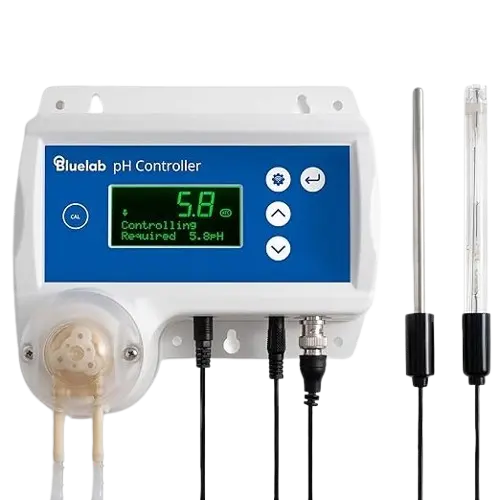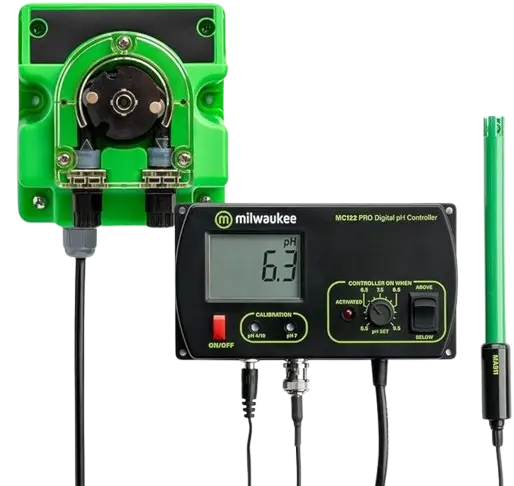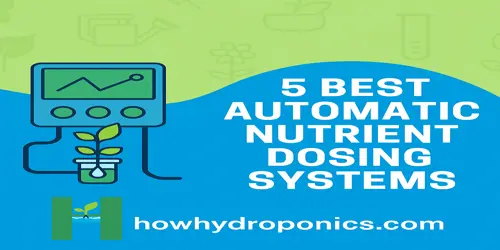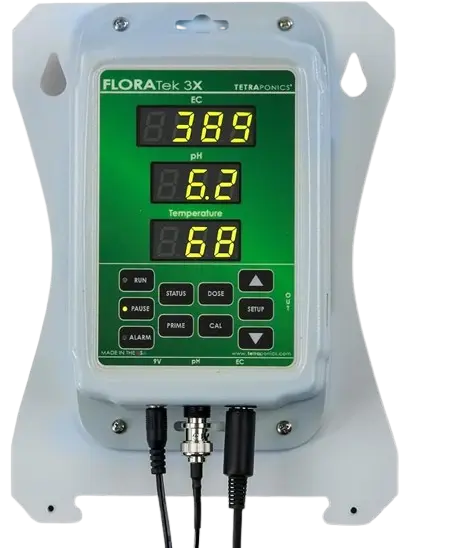Hydroponic nutrient dosing can be challenging and time-consuming for many indoor growers. Over-fertilisation or under-fertilisation can cause a host of problems for your plants, including stunted growth, nutrient deficiencies, or even death. Hydroponic nutrient dosers are automated systems that dispense nutrient solutions into hydroponic systems
Since 2023 the global hydroponic nutrient dosing system market has grown from approximately $8.3 billion in 2023 to $9.07 billion in 2024 and is projected to nearly double (to $18.5 billion) by 2032, growing at a ~9.3% CAGR (1)
Table of Contents
As more and more indoor farmers and urban farmers are shifting to hydroponic growing, there has been a shift from manual dosing to sensor-driven, IoT-enabled, closed‑loop systems.
In this post, we’ll look at the best automatic hydroponic nutrient dosers available. Here is a TLDR version if you are looking for a comparison chart of the best automated hydroponic nutrient dosing systems.
Comparison Table for the Top 4 Automated Nutrient Dosing Systems for Hydroponics
| Feature | Bluelab pH Controller Wi‑Fi | Bluelab IntelliDose Controller | Milwaukee MC720 pH Controller & Pump | Landtek Dual‑Relay pH Controller |
|---|---|---|---|---|
| Image |  |  |  |  |
| Pumps / Relays | 1 peristaltic (pH up/down) | Up to 9 (nutrients + pH) | 1 dosing pump | 2 dosing pumps via dual-relay |
| Controlled Params | pH only | pH, EC, temperature | pH only | pH and temperature monitoring with ATC |
| Connectivity | Wi‑Fi remote control | Wi‑Fi/cloud with app alerts/history | Local only | No Wi‑Fi (local firmware & display) |
| Automation Approach | Automated pH correction, auto-resume | Proportional dosing, scheduled sequences | Relay-triggered dosing when pH deviates | Auto pH up/down dosing when out of range |
| Data & Display | LCD pH & status readout | LCD with pH, EC, temp & pump status | LCD pH display w/ calibration controls | 3‑day pH & temp chart, min/max/avg indicators |
| Calibration & Safety | Lockouts & alarms | Full alarms, lockouts | Out‑of‑range alarm | Auto temperature compensation (ATC), dose counting |
| Use Case | Basic remote pH control | Advanced multi-nutrient systems | Simple single-reservoir setups | Small/medium hydroponics or aquarium pH automation |
| Check Current Price on Amazon | Check Price of Bluelab pH Cont. | Check Price of Bluelab Intellidose | Check Price of Milwaukee MC720 | Check Price of Landtek pH Cont. |
While I have already shared the list of the top 3 nutrient dosers with you, now, if you are interested, I will try to answer all your doubts and queries related to automated dosers. You might be wondering if you need a nutrient doser or not ? Or maybe how does an automated doser even work? Is there any training required to operate such a complex device? Also, a crucial question, how will I shift from manual to automatic nutrient dosing? Let’s dig right in!
Sensor and Automation Technology Advancements in Hydroponics
A scoping review conducted by Hamdan Sulaiman and his colleagues from Universiti Teknologi Malaysia has examined 3,222 studies on automated hydroponic nutrient dosing. Two dosing frameworks stood out in the findings, including the feedback loop framework and predictive analysis. (2)
The primary variables included pH, EC, TDS, and nutrient solution volume, with the help of which an automated nutrient dosing system was being operationalised.
These types of studies suggest that in the upcoming years, we will be able to see automated nutrient dosing systems that are being run by AI systems with predictive modelling capabilities rather than using a fixed framework setup.
How does the automated nutrient doser work?
Nutrient dosers work by mixing a pre-measured amount of concentrated nutrient solution with water and then delivering the mixture to the plants in the hydroponic system. The nutrient dosing process typically involves a few key components, including:
Nutrient solution reservoir
This container holds the concentrated nutrient solution. The nutrient solution is typically made up of a mixture of macronutrients (nitrogen, phosphorus, and potassium) and micronutrients (such as iron, magnesium, and calcium).
Dosage pump
This device draws a precise amount of nutrient solution from the reservoir and dispenses it into the hydroponic system. The pump can be controlled by a timer or a computerized system, which allows growers to automate the dosing process.
pH and EC sensors
These sensors measure the nutrient solution’s pH and electrical conductivity (EC) in real time. This information is used to ensure that the nutrient solution is at the optimal level for plant growth. If the pH or EC levels are too high or too low, the dosing system can adjust the amount of nutrient solution dispensed to bring the levels back into the optimal range.
Read More “5 Best EC & pH Meters for Hydroponics in 2025“
Dosing schedule
The dosing schedule is a program that specifies when and how much nutrient solution should be dispensed into the hydroponic system. The dosing schedule can be adjusted based on the plant’s growth stage, the hydroponic system’s size, and other factors that may affect plant growth.
When to use an automatic hydroponic nutrient doser?
Hydroponic nutrient dosers can be used in a variety of situations where precise nutrient delivery is important. Here are some common scenarios where growers might use a nutrient doser:
Large hydroponic operations
In large hydroponic operations, it can be difficult to mix and dispense nutrient solutions manually. A nutrient doser can automate this process, allowing growers to deliver precise amounts of nutrients to their plants without the need for manual mixing.
High-value crops
For high-value crops like cannabis or exotic herbs, precise nutrient delivery is critical for maximizing yield and quality. A nutrient doser can ensure that plants receive the optimal amount of nutrients at each growth stage, resulting in healthier plants and higher yields.
Inconsistent water quality
If the water quality in a grower’s area is inconsistent, it can be difficult to maintain consistent nutrient levels in a hydroponic system. A nutrient doser can help by automatically adjusting the nutrient solution to compensate for changes in water quality.
Time constraints
For growers with limited time to devote to their hydroponic systems, a nutrient doser can be a valuable tool. With a nutrient doser, growers can automate the nutrient delivery process, freeing up time for other important tasks.
Remote growing
For growers who cannot physically access their hydroponic systems regularly, a nutrient doser can be a useful tool for remotely monitoring and adjusting nutrient levels.
Let’s check out the top 5 nutrient dosers for automating your hydroponic gardens. We will also look at some of the pros and cons each one has and if its good for beginners or only pros.
Top 5 Automated Nutrient Dosing Systems
1- Bluelab pH Controller Wi-Fi 24/7 Reservoir Monitoring
Ideal for professional/ small scale commercial growers
A 24/7 automated reservoir monitor with built‑in Wi‑Fi and Edenic app integration. It controls pH and multi-part nutrient dosing when paired with PeriPods, monitors EC and temperature via replaceable probes, and includes safety features like dosing lockouts, alarms, and auto‑resume after power loss
| Pros | Cons |
| User friendly interface with LCD display | |
| Highly accurate measurement | Takes some time to understand all features |
| Fully Automated pH and nutrient control | Regular maintenance |
| Compatible with various growing systems | Power outage resets setting |
The Bluelab Pro Controller can be used with any hydroponic system, including recirculating, drain-to-waste, and run-to-waste systems. It is also easy to use, with a simple and intuitive interface.
2. Bluelab IntelliDose Controller Kit Automated 24/7 Reservoir pH, EC, Temp Control with Wi-Fi
Ideal for medium to large scale growers
The Bluelab IntelliDose is a comprehensive hydroponic management system offering 24/7 automated dosing of up to nine nutrients, pH chemicals, and additives, with four 24 VDC pump outputs that can also serve as an irrigation controller.
With Wi‑Fi connectivity through Edenic IntelliLink, users get remote access, real-time alerts, and detailed data history via a mobile app.
| Pros | Cons |
| Supports up to 9 nutrients, pH chemicals, and additives, plus 4 outputs | High one-time cost |
| Uses intelligent, sequential pump control | Initial configuration requires time and learning |
| Displays EC, TDS, pH, temperature, and water level | Pumps are sold separately |
| Includes alarms, dosing lockouts, and dry-run protection | Only one direction dosing for pH per unit |
| Real-time alerts, historical data, and remote monitoring | Only one direction of dosing for pH per unit |
3. Milwaukee MC720 Dosing Pump Kit
Ideal for hobbyist or small scale growers
The Milwaukee MC720 dosing kit is a simple and affordable solution for automating the dosing of liquid nutrients and pH adjusters in hydroponic and aquarium systems. The kit includes a compact peristaltic pump, pH and conductivity probes, and a controller that can be programmed to deliver precise dosages at set intervals.
| Pros | Cons |
| Reliable 24/7 pH control: | Single direction dosing |
| Comes with everything included | Without a cycle timer, |
| Worth the money | Entirely local control—no Wi-Fi |
| Simple dial controls and manual calibration | Probe replacement every ~6 months |
4. Landtek Dual Relay Automatic pH Controller with Dosing Pump
Ideal for hobbyist or small scale growers
This dual-relay pH controller automates dosing with two plug sockets for pH up/down regulation.
It features a large display, real-time pH and temperature monitoring with automatic temperature compensation (ATC), alarm functions, and three-day data tracking.
Ideal for hydroponics, aquariums, and nutrient reservoirs needing affordable pH automation.
| Pros | Cons |
| Dual Relay Dosing (pH up and Down) | No Wi‑Fi or app connectivity |
| Built-in ATC & temperature tracking | Wall-mountable bulk unit |
| 3-day data chart and stats | no export or cloud storage |
| Dual sockets enable easy pump integration | Probes require regular calibration |
You have already seen the top 4 recommendations for automated hydroponic nutrient dosers; the next one is a bonus for all of you guys. Why is this a bonus? Because this one is manufactured by a small business based of the USA and needs our support, hence we would like you to take a look at this American beauty!
Bonus : FLORATek 3X Upgraded Hydroponics Control System
Ideal for small to medium scale hydroponic gardens
The Tetraponics FLORATek 3 Pro is an American-made dosing system with proportional smart feed control for efficient dosing of nutrients and pH adjustment. It features three multi-speed pumps, which can be configured for one pH and two nutrient solutions or dual pH and one nutrient solution.
Pros | Cons |
| automatically manages pH and two nutrients | Lacks Wi‑Fi or app control |
| Tracks pH, EC (ppm), and temperature | Simple display and manual programming |
| Fits 5–100 gal tanks | Only three pump outputs |
| One-year warranty and US-based customer service | |
| Delivers precise nutrient levels |
Things to keep in mind while shifting from manual to automatic nutrient dosing
Shifting from manual dosing to automatic nutrient dosing in hydroponics can offer many benefits, such as improved accuracy, consistency, and efficiency. However, there are a few important things to keep in mind to ensure a successful transition:
Choose the right automatic dosing system
There are different types of automatic dosing systems available in the market, such as peristaltic pumps, venturi injectors, and dosing controllers. Choose the one that suits your hydroponic setup and meets your nutrient-dosing requirements.
Calibrate the dosing system
Before using the automatic dosing system, it is important to calibrate it properly to ensure accurate dosing. Follow the manufacturer’s instructions carefully to calibrate the dosing system correctly.
Monitor the nutrient solution regularly
With automatic dosing, it can be easy to assume that everything is working fine. However, it is essential to regularly monitor the nutrient solution to ensure that the plants are getting the right amount of nutrients.
Start with small doses
When starting with automatic dosing, it is best to start with small doses and gradually increase them as needed. This will help avoid overfeeding the plants and causing nutrient imbalances.
Have a backup plan
In case of any technical issues or malfunctions, it is important to have a backup plan in place to avoid any interruptions in nutrient supply to the plants.
Overall, shifting from manual dosing to automatic nutrient dosing in hydroponics can be a great investment in your crop’s success. With careful planning and attention to detail, the transition can be smooth and successful.


